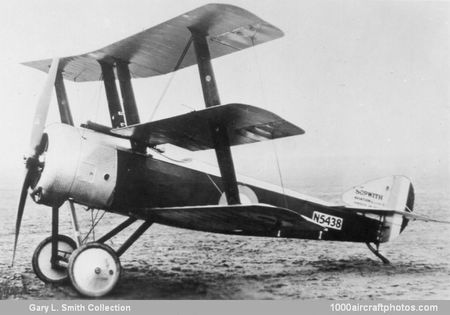The first prototype of what was to be referred to simply as the Triplane was completed in May 1916, its radical wing arrangement of triple narrow-chord main planes, with ailerons on all three wings and single broad-chord interplane and center section struts, resulted in exemplary maneuverability and, for its day, a phenomenal climb rate.
A measure of the success of the Sopwith Triplane after making its combat debut with the RNAS was provided by the extraordinary variety of single-seat fighters of similar configuration hurriedly developed by German and Austro-Hungarian companies. Initially powered by the 110 hp Clerget 9Z nine-cylinder rotary, but more usually being fitted with the 130 hp Clerget 9B, the Triplane began to appear in production form late in 1916, joining combat in the following February.
Armament normally comprised one synchronized 0.303 in (7.7 mm) machine gun, but a few were fitted with twin weapons of this caliber. At least one aircraft was tested with a 110 hp Le Rhône engine. Although the Triplane was ordered for both the RNAS and RFC, it was, in fact, used operationally by the former service only, an agreement having been reached in February 1917 under which the RNAS exchanged all its SPAD S.VIIs for all the Triplanes then on order for the RFC.
As a result, contracts were reduced and only some 150 were completed, the Triplane's operational career being brief, and its replacement by the Camel in Naval squadrons commencing as early as July 1917. The pictured aircraft was written off at Furnes, Belgium, a few months earlier, April 28, 1917. Flight Sub Lieutenant Ronald Felix Collins bounced this Triplane when trying to land, took off again, stalled and side-slipped in from 50ft wrecking the machine, Collins subsequently died of his injuries.
The following data relate to the 130 hp Clerget-engined Triplane.
Span: 26 ft 6 in (8.08 m)
Length: 19 ft 6 in (5.94 m)
Height: 10 ft 6 in (3.20 m)
Wing area: 231 sq.ft (21.46 sq.m)
Weight empty: 993 lb (450 kg)
Loaded weight: 1,415 lb (642 kg)
Max speed: 116 mph (187 kmh) at 6,000 ft (1,830 m)
Climb: to 6,500 ft (1,980 m) 6 min 20 sec
Endurance: 2 hr 45 min
